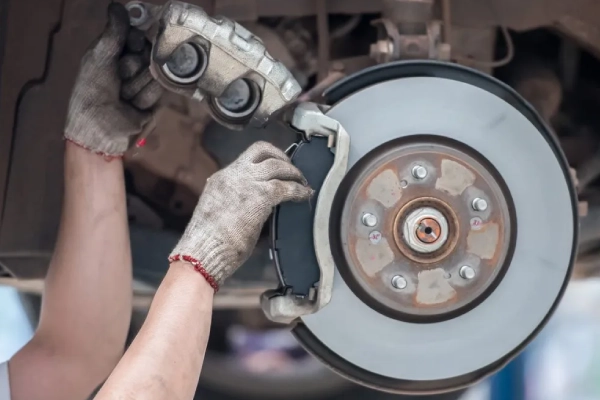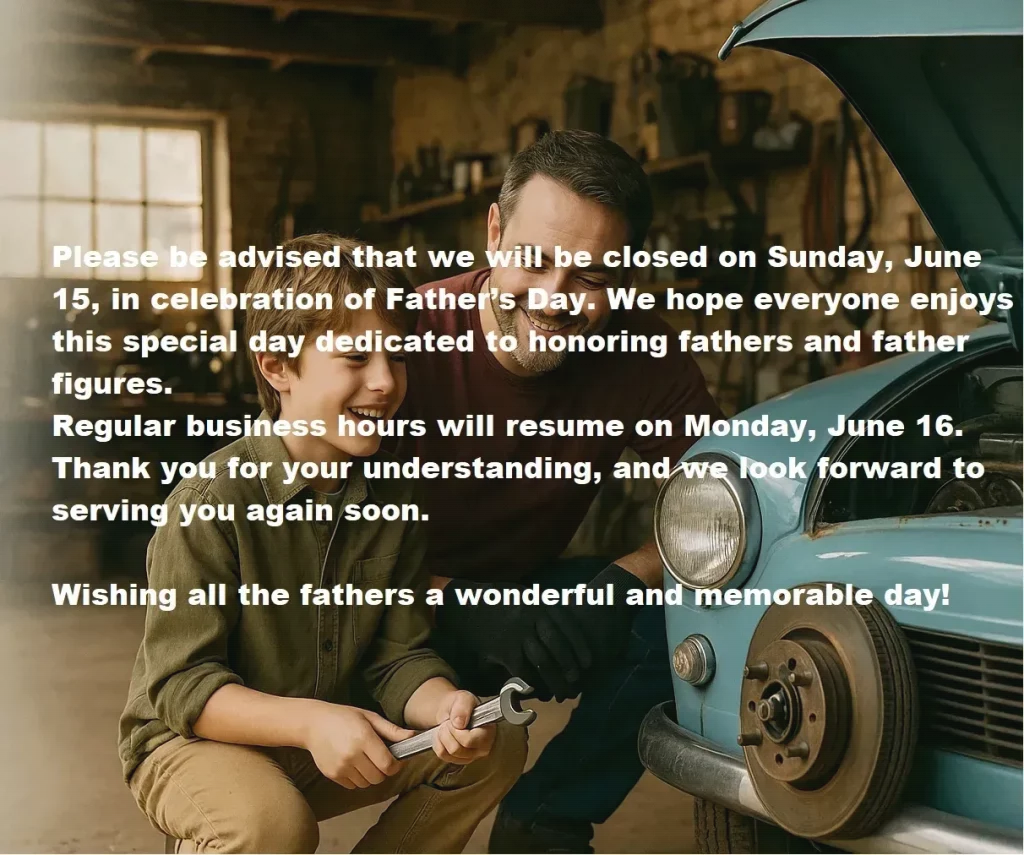Signs of Worn Brake Pads: How to Know It’s Time for a Change
Your brakes are your car’s most critical safety system. Signs of worn brake pads aren’t something to ignore.
Whether you’re hearing odd noises, feeling a delay when stopping, or noticing changes in your braking performance, these signs can be the early warnings that your brake system needs attention.
Recognizing the symptoms early can save you money, prevent accidents, and extend the life of your braking system.
In this guide, we’ll break down the most important indicators of brake pad and rotor wear, what they mean, and when you should act. We’ll also address common myths, preventative tips, and why you should never put off brake maintenance.
What Are the Signs of Worn Brake Pads and Rotors?
The most obvious indicator is a squealing or grinding noise when applying the brakes. This usually means the pads have worn down to the metal, and now you’re getting metal-on-metal contact with the rotors.
That’s not just noisy—it’s dangerous and damaging to your braking system.
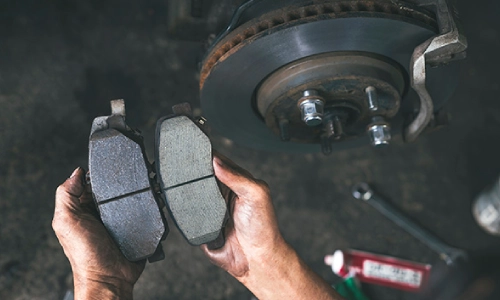
Other key signs include:
- Increased stopping distance even under light braking conditions
- Vibration or pulsation in the brake pedal or steering wheel during braking
- A visible thinning of the brake pad material (less than a quarter inch is a warning sign)
- A brake warning light appearing on your dashboard
- Scoring or grooves on your rotors, which suggest pad failure over time
In some cases, you might even smell a burning odor, particularly after heavy or sudden braking. This can indicate overheating pads or even damage to the rotor surface.
Brake pads and rotors work together as a system. If one is compromised, the other usually suffers as well. Addressing one without the other can lead to uneven wear and additional repair costs down the line.
Contact us for engine diagnostics and repair services
Signs of Worn Brake Pads Noise: What Does That Sound Mean?
Noise is often your car’s first attempt to tell you something’s wrong. The specific sound matters:
- High-pitched squealing is usually a wear indicator tab built into the pad that scrapes against the rotor when it’s time to replace the pad.
- Grinding or growling suggests that the pad is completely worn and the caliper is now pressing directly against the rotor.
- Clicking or rattling can indicate that brake components, such as anti-rattle clips or calipers, are loose or misaligned.
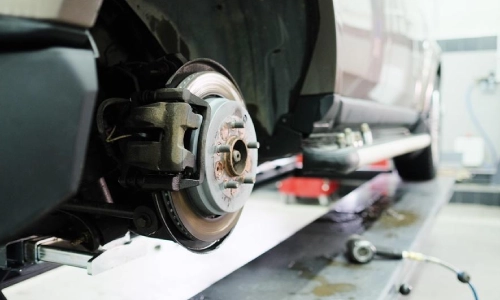
These signs of worn brake pads noise aren’t just annoying—they’re critical warnings that shouldn’t be ignored. Acting quickly can help you avoid costlier issues, like warped rotors or a complete brake failure.
Brake Pedal Feel and Response Time
One underrated sign of worn brake pads is how the brake pedal feels under your foot. If it feels different than usual, it’s worth a closer look:
- A soft or mushy pedal can point to worn pads or air in the brake lines.
- A firm pedal that requires extra pressure could indicate glazed pads or a malfunctioning brake booster.
- A delayed braking response is often the result of thinning pads that can’t generate enough friction to stop the vehicle effectively.
A car with healthy brakes should respond immediately and smoothly when the brake pedal is pressed. Anything less than that is cause for concern.
Visual Inspection: What You Can See Without Tools
You don’t need a professional shop to spot the signs of worn brake pads. With the wheels still on, look through the spokes to locate the brake pad. If it appears very thin—under 1/4 inch—it likely needs replacement.
You should also inspect the rotor surface for deep grooves, scoring, or discoloration. If your rotor looks uneven or has a blueish hue, it’s likely overheated from prolonged friction. These are additional signs of worn brake pads and rotors working improperly.
For a more detailed check, remove the wheel and measure pad thickness directly. This gives the most accurate indication of wear.
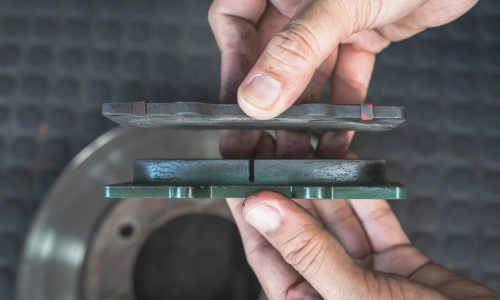
How Worn Brake Pads Affect Your Safety and Performance
Ignoring the signs of worn brake pads doesn’t just affect your ability to stop—it affects your entire vehicle’s safety and reliability:
- Longer stopping distances make accidents more likely, especially in sudden-stop situations
- Overheating components can warp rotors and boil brake fluid
- Brake fade reduces the effectiveness of your entire brake system over time
- Uneven wear can damage calipers and suspension components
Additionally, if your car pulls to one side when braking, it might indicate that one side’s pads are more worn than the other, possibly due to a stuck caliper. Uneven wear stresses your vehicle’s suspension and handling.
Get in touch with us for vehicle brake service and replacement
When to Check for Signs of Worn Brake Pads and Rotors
Brake pads don’t last forever, but you can extend their life by monitoring their condition regularly. Some guidelines:
- Inspect brakes every 10,000 to 15,000 kilometers
- Check for noises and response issues after driving in rain or on steep terrain
- Watch for drops in brake fluid, which may indicate pad or caliper problems
- Check rotor condition whenever you rotate or replace tires
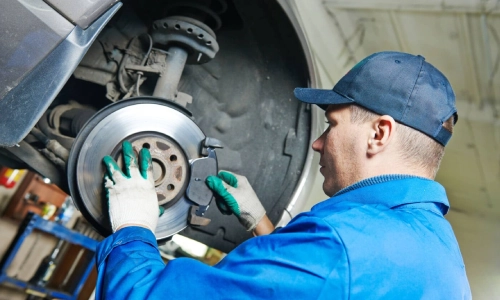
Even if everything seems fine, regular maintenance can uncover early signs of worn brake pads and rotors that haven’t shown symptoms yet.
How Long Do Brake Pads Typically Last?
Most brake pads last between 40,000 and 80,000 kilometers, but that range depends on:
- Your driving style (aggressive braking = faster wear)
- Terrain (hilly or mountainous areas wear pads faster)
- Type of pad material (ceramic vs. metallic vs. organic)
- Vehicle load and towing frequency
If you do mostly city driving with frequent stop-and-go traffic, your pads will wear down more quickly than someone who drives mainly on highways.
Engine diagnostics and repairs Calgary
Common Myths About Brake Pad Wear
Let’s bust a few common myths that can lead drivers to ignore critical signs:
- “If the car still stops, it’s fine.” Wrong. Pads can be dangerously thin but still provide minimal stopping power.
- “Brake noise is just part of driving.” No. Any noise is a sign of an issue.
- “I’ll just wait for the light to come on.” The brake warning light is often a late-stage alert.
- “All pads wear evenly.” They don’t. Pad wear depends on weight distribution, driving habits, and even tire condition.
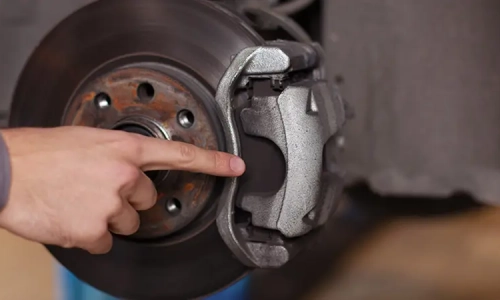
Preventative Tips for Extending Brake Pad Life
You can get more life out of your brake pads by following these habits:
- Drive smoothly, anticipating stops instead of slamming the brakes
- Avoid tailgating, which leads to constant braking
- Downshift or use engine braking when descending long slopes
- Flush your brake fluid regularly to maintain hydraulic performance
- Keep your tires properly inflated to reduce unnecessary brake stress
Well-maintained brakes are safer, quieter, and much cheaper to maintain over time.
Frequently Asked Questions (FAQ)
Common signs of worn brake pads include squeaking or squealing noises, vibrations when braking, longer stopping distances, and reduced braking power. If you notice any of these signs, it’s time to have your brakes checked.
Look out for indicators such as high-pitched squeaking or grinding sounds, vibration when braking, or if your car takes longer to stop. These are clear signs that the brake pads are worn and need replacement.
Yes, worn brake pads can significantly reduce braking efficiency, increasing the risk of accidents. Replacing them early ensures your vehicle’s safety and avoids costly repairs down the road.
Brake pads generally last between 30,000 to 70,000 kilometers, depending on your driving habits. However, it’s always a good idea to check your brake pads regularly to ensure they’re in good condition.
If you notice any of the signs of worn brake pads, bring your car to a trusted mechanic for an inspection. It’s crucial to replace brake pads early to maintain safe driving conditions and avoid further damage to the brake system.
Conclusion: Don’t Wait to Address the Signs of Worn Brake Pads
The earlier you spot the signs of worn brake pads, the easier and more affordable the fix. Listen for odd noises, pay attention to pedal feel, and visually inspect your pads and rotors regularly. These are small steps that can make a big difference.
Don’t wait until your brakes fail to act. If you’re in Calgary, Canada, and you suspect something’s wrong with your brake system, raptorsauto offers professional inspection and replacement services to get you safely back on the road.
Book your brake check today—because your safety should never be put on hold. For more information and to take advantage of our services, get in touch with the experts at RaptorsAuto.

